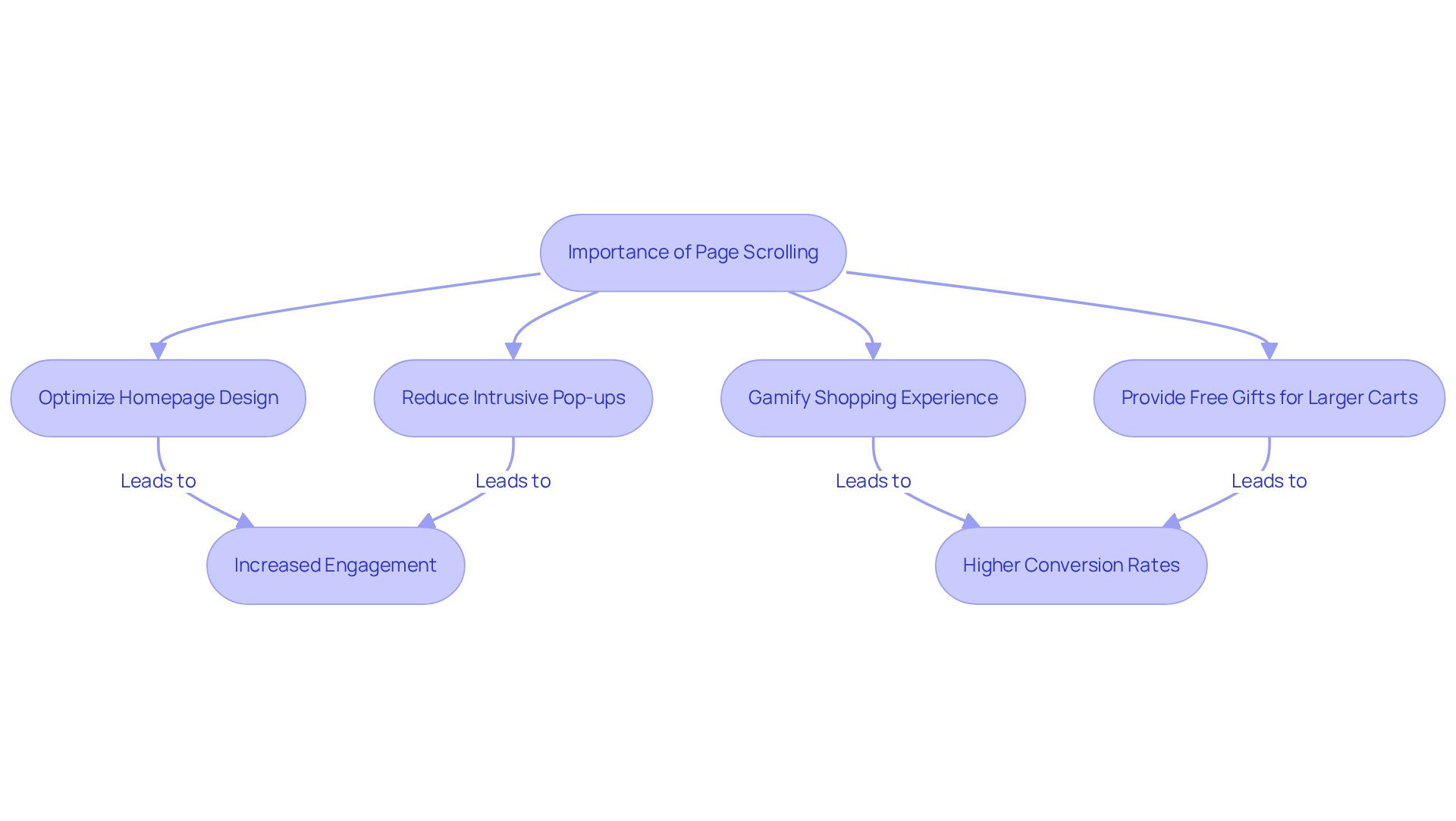
Overview
This article delves into the best practices for optimizing page scrolling, a crucial factor in enhancing user experience and driving success for direct-to-consumer (DTC) brands. Effective scrolling techniques, such as visual indicators and a logical flow of content, are not just recommendations; they are essential strategies that can significantly elevate user engagement and conversion rates.
Consider the impact of these techniques: case studies reveal substantial increases in brand performance when strategic enhancements are implemented. For instance, brands that have adopted these scrolling practices report higher user retention and increased sales, showcasing the direct correlation between optimized scrolling and business success.
To truly grasp the importance of these practices, it’s vital to recognize that the user experience is paramount. By employing effective scrolling methods, brands can create a seamless journey for their customers, guiding them effortlessly through content. This not only keeps users engaged but also fosters a deeper connection with the brand.
In conclusion, DTC brands must prioritize the optimization of page scrolling. By integrating visual cues and maintaining a coherent content flow, they can enhance user experience, drive engagement, and ultimately boost conversion rates. The evidence is clear: strategic enhancements in scrolling techniques lead to measurable success.
Introduction
Page scrolling has emerged as a crucial element of user experience, especially for direct-to-consumer (DTC) brands aiming to capture and retain customer attention. Online shoppers increasingly prefer seamless navigation over cumbersome clicks, making the optimization of scrolling a key factor in enhancing engagement and boosting conversion rates.
However, how can brands find the right balance between captivating design and functional usability to prevent user frustration? This article explores effective scrolling techniques and best practices that not only elevate user interaction but also drive sales, paving the way for DTC brand success in a competitive digital landscape.
Understand the Importance of Page Scrolling in User Experience
Page scrolling is essential for shaping visitor experience and significantly influences how individuals interact with a website. For DTC brands, effective navigation methods enhance engagement by enabling smooth exploration of content. Research shows that users are more inclined to interact with material that is easily accessible through swiping rather than navigating through multiple links. This trend is particularly evident in mobile browsing, where page scrolling often feels more intuitive than clicking. Brands like Chewy exemplify this approach by featuring top-selling items directly on their homepage, making it easier for customers to discover offerings without unnecessary navigation.
Moreover, employing visual cues, such as arrows and partially visible content, can guide users in their page scrolling, thereby enhancing their overall interaction. Studies indicate that thoughtfully designed navigation can lead to increased time spent on the site and improved conversion rates. For instance, Parah Group's case studies reveal that:
- Optimizing homepage design
- Reducing intrusive pop-ups
- Gamifying the shopping experience
- Providing free gifts for larger cart sizes
can significantly elevate engagement levels. A $30M apparel brand experienced a remarkable 35% increase in conversion rates through these strategic enhancements.
Conversely, brands that prioritize aesthetics over functionality often encounter high bounce rates and low engagement. By recognizing the importance of movement and implementing effective strategies—such as those highlighted in the FAQs about CRO—DTC brands can create a more engaging and user-friendly experience. This approach ultimately drives higher conversion rates and fosters customer satisfaction, as demonstrated by the success stories of brands that collaborated with Parah Group to adopt innovative CRO strategies.

Explore Effective Scrolling Techniques and Their Psychological Effects
Efficient navigation methods—like infinite movement, parallax movement, and page scrolling—are crucial for enhancing visitor engagement on websites. Endless browsing allows users to access content seamlessly, fostering prolonged engagement and discovery. However, introducing this feature requires caution; poorly executed page scrolling and infinite movement can frustrate users and hinder their ability to locate specific products. For instance, e-commerce platforms such as Unsplash and Pinterest effectively leverage endless browsing to facilitate product discovery, ensuring users can navigate smoothly without feeling overwhelmed.
Parallax page scrolling, on the other hand, creates an immersive experience by adding depth to the visual presentation of content, captivating users and encouraging deeper exploration. Additionally, page scrolling can effectively trigger animations that draw attention to key elements, guiding users through the content in a more engaging manner.
Understanding the psychological impact of these techniques is vital for direct-to-consumer (DTC) brands. The innate desire for exploration and the gratification derived from uncovering new content can significantly influence user behavior. Brands that harness these insights can craft engaging experiences that not only captivate audiences but also drive conversions. Nonetheless, balancing engagement with usability is essential to avoid frustration, ensuring users remain satisfied and eager to interact with the site.

Implement Best Practices for Optimizing Page Scrolling
To optimize page scrolling effectively, DTC brands must adopt key strategies that enhance user engagement and drive conversions:
-
Employ Visual Indicators: Integrate arrows, scroll markers, or subtle animations that signal to users that more content awaits below the fold. Research shows that over 66% of attention is concentrated in these areas, underscoring the importance of encouraging page scrolling.
-
Ensure a Logical Flow: Structure content coherently to guide visitors seamlessly through the page. This organization not only helps users find information easily but also enriches their overall experience, motivating them to delve deeper into the site.
-
Incorporate Sticky Navigation: Implement a sticky header or navigation bar that remains visible as users scroll. This feature provides easy access to various sections of the site, preventing users from losing their place and enhancing navigation efficiency.
-
Optimize Load Times: Fast-loading pages are crucial for retaining visitor interest. Slow load times can lead to abandonment; thus, optimizing images and utilizing content delivery networks (CDNs) can significantly boost performance.
-
Test and Iterate: Regular A/B testing is vital to identify which scrolling techniques and layouts resonate best with users. Continuous optimization based on real user behavior can lead to improved engagement and higher conversion rates.
By implementing these strategies, DTC brands can cultivate a more engaging online shopping experience through effective page scrolling, ultimately driving higher conversion rates and enhancing customer satisfaction.

Conclusion
Optimizing page scrolling is essential for enhancing user experience, especially for direct-to-consumer (DTC) brands. Smooth navigation is not just a luxury; it’s a necessity that fosters deeper engagement and drives higher conversion rates. A well-designed scrolling experience captivates users, encouraging them to explore more content without frustration.
Key insights reveal the importance of:
- Visual indicators
- Logical content flow
- Sticky navigation
- Fast loading times
Each element is vital in keeping users engaged and satisfied while navigating a website. Moreover, the psychological impact of scrolling techniques can significantly influence user behavior, underscoring the need for DTC brands to balance engagement with usability.
In today’s competitive digital landscape, prioritizing page scrolling optimization can distinguish brands from their competitors. By embracing these best practices, DTC brands can craft an intuitive and enjoyable online shopping experience that not only retains visitors but also transforms them into loyal customers. This approach goes beyond aesthetics; it’s about understanding user behavior and creating an engaging journey that leads to increased satisfaction and conversions.
Frequently Asked Questions
Why is page scrolling important for user experience?
Page scrolling is essential for shaping visitor experience and influences how individuals interact with a website, particularly for DTC brands. It enhances engagement by allowing smooth exploration of content.
How does scrolling compare to clicking in terms of user interaction?
Research shows that users prefer interacting with material that is easily accessible through swiping rather than navigating through multiple links, especially in mobile browsing where scrolling feels more intuitive than clicking.
Can you provide an example of a brand that effectively uses page scrolling?
Chewy is an example of a brand that features top-selling items directly on their homepage, allowing customers to discover offerings easily without unnecessary navigation.
What strategies can enhance page scrolling and user interaction?
Employing visual cues like arrows and partially visible content can guide users in their page scrolling, enhancing their overall interaction.
What are the benefits of thoughtfully designed navigation?
Thoughtfully designed navigation can lead to increased time spent on the site and improved conversion rates, as evidenced by case studies from brands like Parah Group.
What specific strategies have been shown to elevate engagement levels?
Strategies include optimizing homepage design, reducing intrusive pop-ups, gamifying the shopping experience, and providing free gifts for larger cart sizes.
What impact did strategic enhancements have on a $30M apparel brand?
The brand experienced a remarkable 35% increase in conversion rates through strategic enhancements.
What are the consequences of prioritizing aesthetics over functionality?
Brands that prioritize aesthetics over functionality often encounter high bounce rates and low engagement.
How can DTC brands improve user experience and conversion rates?
By recognizing the importance of movement and implementing effective strategies, DTC brands can create a more engaging and user-friendly experience, ultimately driving higher conversion rates and fostering customer satisfaction.
FAQs











